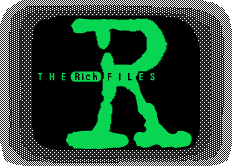
How to build SPinTerface cartriges...
If after reading this you wish you could have a particular device on your 85, then you really ought to have a SPinTerface port installed on your TI-85. If you don't have one yet, and you feel you need it and have the expertice to install it, then I recomend the instalation.
The SPinTerface is a 10-pin port that has a serial interface and a 5v+ regulated power supply. Its design automaticly turns off the voltage regulator to save power when nothing is connected. It also makes sure all the pins are connected before power comes on and it turns off all power before the device is disconnected. I have used it to connect speakers, and memory expansion, and if anyone wants to get into it, they could create all kinds of other devices to it also!
Speakers are pretty simple. There have been speakers designed for the link port, but one could be made into an all in one case that wouldn't need an expensive 2.5" plug. You can connect it directly to the SPinTerface's serial port, or even use the power supply to run a tiny amplifier!
I won't go into too many details with some things. I want people to design their own things! It will promote creativity and it will mean devices do exactly what you want. I will however, show how to connect the NM29A080/040V chips (used in the SF Expander) to the SPinTerface port. I'll also tell you how to build a super CHEAP speaker cart with a built in amplifier and I'll show you where you can get really awesome looking cases for your small one or two chip cartridge projects.
The SF Expander, created by Mel Tsai, was my inspiration for the SPinTerface port. I loved the simplicity of the SF Expander when compared to its function, but I didn't want to have to drag another box around (I already have an 85 and an 82 that I take EVERYWHERE). My brother had just got a GameBoy Pocket, and I got a VirtualBoy. I was going to build connectors for them that would let me use cheap powerpacks with them, rather than going out and buying a $16.00 custom pack for each one that can't be used for anything else. I was suddenly inspired! I didn't want an external device for my TI-85, so maybe I could build it right into it! It was just like my VirtualBoy. I was going to build a connector right into it to run off of a standard powerpack. Why not build a "powerpack" directly into the TI-85. I used a design compatible with the SF Expander's chip. I soon discovered that I could run a small LED of this power supply without even dimming the screen! (NOTE: This depends on the power the LED requires. Some other projects may need a battery expander to run without dimming the screen). I realized at that moment that this thing gives you more power than I had ever realized, and that its potential went far beyond memory expansion!
I will first show you how to build a very, very nice looking case for small projects.
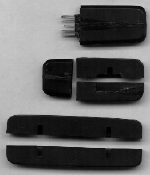
The illustration above shows what the case and its components look like. Those plastic pieces are VirtualBoy gamepack covers, and Nintendo used to give them out for free! I'm going to get a bunch of these things so I have nice little cases for these things. If you need an order form to send for these FREE gamepack covers, you can call 1-800-255-3700 Monday-Saturday, 4:00am-12:00, Midnight, and Sunday, 6:00am-7:00pm, Pacific time to get one. NOTE: due to the age of the Virtual Boy, and it's UN popularity, you may not be able to get these case cover any more.
If you need a bigger case, you can just glue two of these covers together. I think it may be able to hold 3 small chips, such as the memory chips I mentioned before. If you just need room for one chip (This is what you'd use for the SF Expander cartridge) you can cut one in half and glue them together as shown, and put the plug on the end or the side of it. I like how it looks with the plug on the end, but it might get in the way, especialy when you play video games. If you do build the SPinTerface, see if you can't build the port to come out from the bottom rather than the side. If you don't think you can work in that small space, you can create low profile cartridges by putting the connector on the side rather than the end. If you don't want it to be full lenth, you can just cut them to a good lenth and super glue the four pieces together.
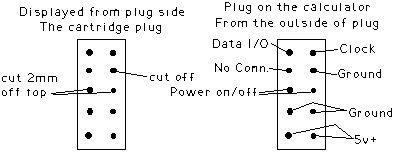
The connector is the most important part that will be visible. The illustration shows that you need to cut the pin with no connection completely off (or heat it with a soldering iron and pull it out with a pliers) and that the two pins in the middle row need to be cut about 2mm off the tips. The reason for the short middle pins is so the power (activated by these pins) won't come on till all the other pins are connected. The power then is also shut off before any other pin is disconnected as you remove a cartrige. This is only nescesary for cartridges that require power. Some may not require power (non amplified speaker, etc.) and you don't need to worry about the middle pins. If the project is powered however, you should cut the pins to their shorter lenth and then you mustsolder those two pins together, inside the cart. What you get is one of the very few types of cartridges that you CAN insert and remove without having to shut anything off. It's all automatic and it's all hot swapable!
The SF Expander cartridge uses the 10-pin plug, a .1µf ceramic disk capacitor, a 2.2K resistor, and an NM29A080/040 chip. The chip is a hard to find part. They are nolonger made. It is still possible to find them, but the only way is to find someone who is interested in selling one they have. I am working on a simple serial/parralel interface that would work just like the SF Expander did, but the interface converter would use parallel chips instead of serial chips. This PF Expander, if It becomes a successful project, would be a solution for those who don't want to build a PIC or microcontroler based expander. It would have all of the SF Expander's limitations, but it would be something the average electronics hobbyist could build. IF I finnish, I'will post it here!
First off, you will need to have the connector made, as described above. Also, when you solder this thing together, you will want to be extremely quick and precise, because you do NOT want to overheat the chip. There is a something important you must read before you go on!!! The PLCC Chip case that is used for the NM29A080/040 chips needs modification to fit into the virtual boy gamepack cover case that you should have built. The chip itself fits, but the leads prevent it from going in easily. You can take a pliers and flatten the rounded lead bottoms. If you like, you can even snip off all the leads that aren't used and flatten the ones that are left, but you MUST BE CAREFUL!!! If you slip, you could break off an important lead!

If you can find it, get the SOIC(?) version. It's very thin. They will be harder to find. Most are the PLCC type. It realy doesn't matter which chip you get since both will work and both can be made to fit into the cases. Also, I would recomend tinning the leads of the chip before beginning. This simply means that you put a thin layer of solder on the lead so you can put the solder on the wire and bond the wire and the chip almost instantaneously. Only solder the wires and parts to the sides, and make sure the wires won't touch and that all the parts can slide in easily. The only pins used are 1, 4, 5, 6, 7, and 28/32 depending on which chip you use (Remember, if you want to cut the others off, you can, but be careful). The circuit is very simple. First, connect the resistor between pins 6 and 7. Connect a wire from pin 6 to the data pin (top, right from solder side of connector). Then connect pins 1 and 4 with a jumper wire. Solder two wires to both ends of the capacitor and then solder the capacitor to pins 4 and to 28/32 (depends on the chip. 28 or 32 is always the last pin). Solder the wire on the capacitor that connects to pin 4 to the ground pins and have ajumper from the ground pins to the signal ground. The wire on the other side of the capacitor (connected to pin 28/32) connects to the two 5v+ pins on the connector. Last is to connect a wire from pin 5 to the clock pin on the connector. All the wires should be short and you can't fold the capacitor or the resistor over the chip or it won't fit into the case. Slide it into the case after you have made sure it works by testing it. You may want to let a drop or two of super glue fall into the cartridge to hold the chip down. Then super glue the connector to the cartridge case. You'll have finnished your SF Expander cartridge for the SPinTerface port.
|
The SF Expander cartridge was created by me, Richard Piotter. The electronics design was adapted from the SF Expander, built by Mel Tsai. The Expander and expander cartridges provide 512K or 1 Megabyte storage for the TI-85. Mel has all rights to the software and SF Expander design however. I only modified the design to work as a SPinTerface cart. (Instructions above) SF Expander Driver Beta SF Expander Driver for ZShell V1.0 SF Expander Driver for Usgard V1.0 The TI-Memory Expansion Homepage If these links are dead, it's because Mel nolonger works with TI stuff. Go to ticalc.org for files relating to old and new memory extenders. | ||||||||||||||||||||||||||||||||||||
A speaker cart with a built in transistor amplifier, designed by Richard Piotter, can be built easily following my design. Get a low power piezo electric speaker, an NPN transistor like the 2N2222 or the 2N4954, and a very small rotary variable resistor (Radio Shack has them all). The variable resistor I used was about 10K, but I would use a lower value. The screen dims a little with mine and I would strongly suggest using the battery expander with it, since it provides more power, but if you turn your cotrast up a little, you won't notice, but remember, it uses plenty of power. I mean, it is an amplifier, isn't it? As for what programs it works with... Well, PlainJump][, zPong, Playwav, sound, and more. The amplifier is designed to take the signals from the data and clock pins of the SPinTerface port (the labels are based on the SF Expander cart. It would be more accurate to say red and white wire connectors, since that is what they connect if you were going by a Link cable) and run both of them together, through an amplifying transistor. The transistor alone drains massive power and makes the speaker rattle too much, so the variable resistor acts as both a current limiter and a volume control. The SPinTerface amplified speaker is easy to make. Connect the plus side of the speaker to one of the outside pins of the variable resistor. The other outside pin and the middle pin can be joined and then the middle pin connects to the 5v+ terminal on the connector. Connect the other speaker wire to the collector of the transistor. the emitter of the transistor connects to the signal ground, and finaly, join the clock and data pins and then connect both to the base of the transistor. The circuit is now complete. Just make a case now. I made a round hole large enough in the top of one of those virtual boy gamepack covers to hold the speaker (same case as the SF Expander cart). I then made a slot at the end for the volume knob to fit through. the transistor should slide in tightly, but it will slide in. I soldered everything together after cutting the case, but I didn't join the two halves of the case. When I was done, I glud the speaker and the variable resistor into place and then put glue on the joint and joined the two sides of the case together. I then glued the connector on. Once it is dry, you are done, but make sure your knob turns freely! Adding an earphone plug wouldn't be that difficult. I may put up a plan later for a speaker cart with stereo earphones, amplifier shutoff, volume, built in speaker, and a stereo/mono switch, but these things are easy to add. If you absolutely need a design, I'll see if I can post it soon.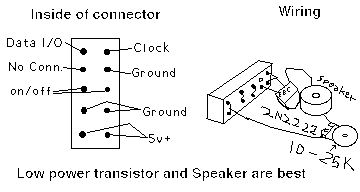 | ||||||||||||||||||||||||||||||||||||
The Piezo Electric Speaker Cartridge. I recomend this one because it won't crash your calc and won't dim your screen. It unfortunately is a little quieter. The principals are similar and you should use a similar, if not smaller resistance potentiometer for it. It does not use a transistor amplifier, but it should produce enough sound. You may need to work on using the case to cause a mechanical amplification effect. If you buy a plastic cased piezo buzzer from Radio Shack, you won't need to worry about the mechanical resonance.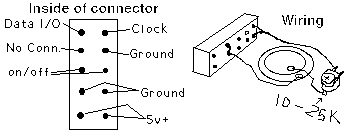 | ||||||||||||||||||||||||||||||||||||
I2C Temperature Sensor Cart (1 Chip version). The One chip version of the I2C Temperature Sensor for the SPinTerface port doesn't actualy use the power supply provided by the port. It uses so little power, that it can draw it off of the serial lines in the port! The software (TEMP.SIT) reads the sensor about twice a second and should run on any TI-85. (NOTE: The temp of the chip is updated twice a second, but that doesn't mean that if you put it in a freezer, it will instantly say 0 degrees Celsius. It takes time for the temp to go down, and it may not even go all the way down because the sensor may not have direct contact. Remember, the case has to reach the current temperature of the atmosphere or the object you're testing, so be patient). The sensor chip's case temperature is the temperature that is shown by the driver software. A tiny probe soldered onto pin 4 (Gnd) should help conduct heat from the probe into the chip, and if the chip is sealed by glue or sealant, then you can even check water teperature. You need to keep the metal probe insulated from electricity, so sealant around it as well would be wise. The capacitor is un marked because I am told that 1uf, 10uf, or 100uf all work. I am using 10uf and it works fine, you should try others too though. The capacitor is there to store power from the serial pins when they are high and release power during the time they go low. It also acts as a filter. The two switching diodes allow power into the capacitor, but doesn't allow the capacitor to send it back into the serial lines when they go low. There may be enough power to run two chips connected in parralel, with different addresses, but I have had problems using the serial port power to run two of them. I recomend this design for only one chip sensors. Use the power supply provided by the SPinTerface for two chip versions. If you need to change the address of the chip, then look at the table displayed with the schematic. Connecting an address pin to ground is the same as setting it to "1." Leaving it Not Connected is a "0." Here is the schematic for the serial line powered I2C Temp Sensor...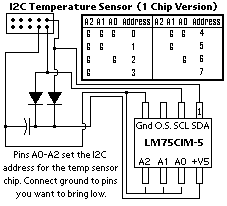 | ||||||||||||||||||||||||||||||||||||
I2C Temperature Sensor Cart (2+ Chip version). The One chip version of the I2C Temperature Sensor for the SPinTerface port doesn't actualy use the power supply provided by the port. It uses so little power, that it can draw it off of the serial lines in the port! The software (TEMP.SIT) reads the sensor about twice a second and should run on any TI-85. (NOTE: The temp of the chip is updated twice a second, but that doesn't mean that if you put it in a freezer, it will instantly say 0 degrees Celsius. It takes time for the temp to go down, and it may not even go all the way down because the sensor may not have direct contact. Remember, the case has to reach the current temperature of the atmosphere or the object you're testing, so be patient). The sensor chip's case temperature is the temperature that is shown by the driver software. A tiny probe soldered onto pin 4 (Gnd) should help conduct heat from the probe into the chip, and if the chip is sealed by glue or sealant, then you can even check water teperature. You need to keep the metal probe insulated from electricity, so sealant around it as well would be wise. The capacitor is un marked because I am told that 1uf, 10uf, or 100uf all work. I am using 10uf and it works fine, you should try others too though. The capacitor is there to store power from the serial pins when they are high and release power during the time they go low. It also acts as a filter. The two switching diodes allow power into the capacitor, but doesn't allow the capacitor to send it back into the serial lines when they go low. The SPinTeface power supply is used run two or more chips, connected in parralel, with different addresses. I recomend this design for temp sensors that require more than one chip sensor. If you need to change the address of the chip, then look at the table displayed with the schematic. Connecting an address pin to ground is the same as setting it to "1." Leaving it Not Connected is a "0." You must remember that no two chips can have the same address. Here's the schematic...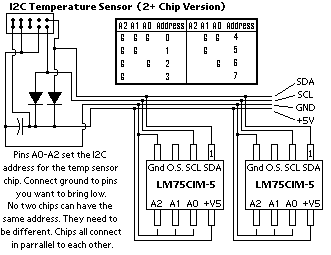 | ||||||||||||||||||||||||||||||||||||
|
| LinkExchange Member | Free Home Pages at XOOM | Free Home Pages at GeoCities |

|
The Richfiles is copyright © 1996-2000. All Rights Reserved.